I’m a relative noob to the world of smallish objective, 1-4X scopes. You’re never going to find me clearing a house in my mall ninja clothes. Despite Foghorn’s best guilt trips, I still haven’t competed in a 2 (or 3) gun competition. But I did sign up for a 7 mile run through the desert next year, and in doing so kicked off a quest for a new kind of scope. Something that could help me engage targets from 25 to 400 yards, but not get in the way doing it. I knew I’d have to slim down. Have I mentioned I’m a cheap bastard too? Enter the Traditions Tactical AR Patrolman 1-4 x 24. And uhhh… I’ll be damned if it isn’t pretty awesome . . .
Seems these days, everyone is jumping on the high speed, low magnification bandwagon. Burris, Nikon, and Leupold all have offerings along with about a dozen other companies. The big three offer windage and elevation adjustments of .5 MOA, eye reliefs of 3.5 – 4.1 inches, weights from 11.5 oz to 17 oz, and overall lengths from 9.4 to 11.3 inches. See below for the specs on the Traditions scope which seems to be pretty middle of the pack relative to the big three.
- 1-4×24 with Illuminated Dot Reticle
- 3-5″ Eye Relief
- 127.3-31.8 FOV at 100 yards
- Overall Length: 10.5″
- Weight: 14.36 ounces
One of the common critiques I’ve read of 1X scopes is that they aren’t “truly” 1X. In other reviews, one of the biggest complaints is that you can’t keep both eyes open acquire a good sight picture. I look at field of view (FOV) as a good “on paper” metric for what type of magnification I should expect from a scope. Of the big three, Burris’ line of 1-4 scopes shows the largest FOV at low power advertising 100 ft at 100 yards. Traditions claims 127.3 feet at the same distance. On the high magnification end of the spectrum, Nikon’s line of scopes claims 23.1 feet of FOV at 100 yards while Traditions says they can do 31.8 inches. So, on paper, it appears Traditions has near as damnit a 1X scope.
My seat of the pants impression validates that. I can keep both eyes open at 1X without too much of a discernible difference except at very close distances. Crank it up to the advertised 4X and it seems to be about four times as big. Make the judgement for yourself using the pictures below taken through the scope at 50 yards. The paper you see is 8.5″ x 11″ and the black dot is a 2″ x 2″ square.
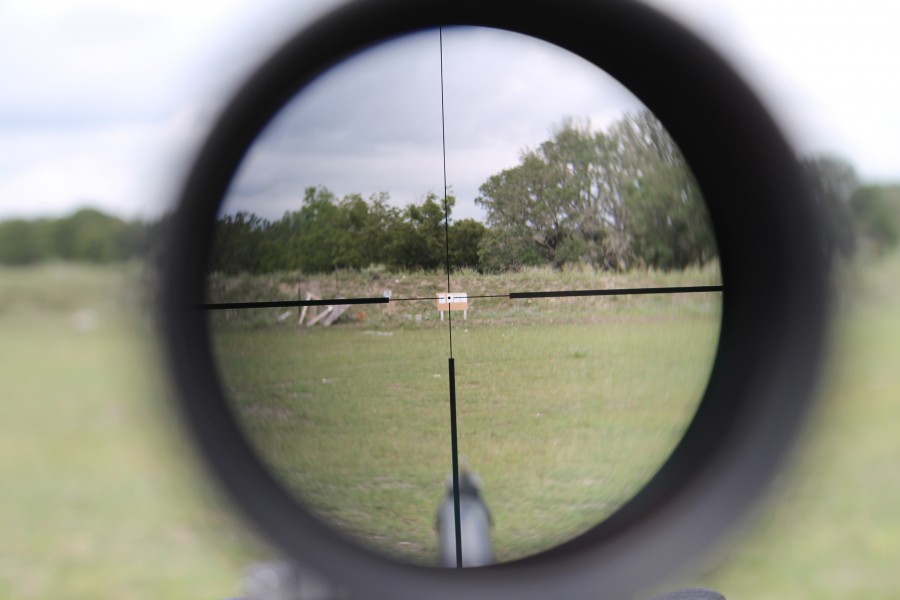
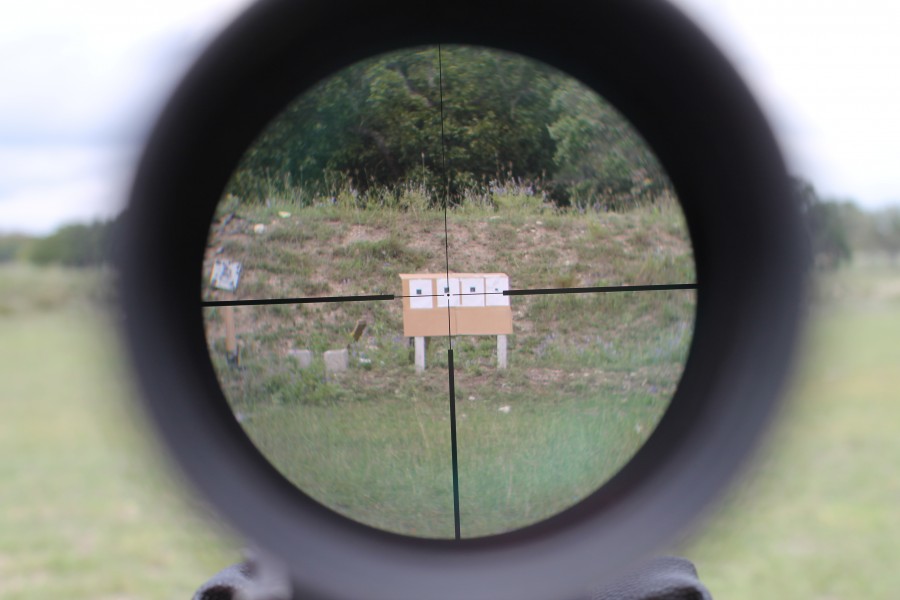
As you can also see, at 4X, the distance between the thick lines in the reticule appears to be ~36 inches @ 50 yards. Several online calculators tell me that the center to edge distance in that case would be ~34 MOA so take that for what it is worth.
A few years ago, I burned through $100 of .223 REM (when that meant something) to find out that the T&E scope I was reviewing was a steaming pile of crap. Since then, I’ve been hesitant to strap a scope to my gun and start shooting until I know that it can perform some basic tests. The first is to use a laser bore sight and spin the turrets up, down, and side to side. Doing this lets me check that the adjustments will return to zero. No matter how I ran the Traditions’ turrets back and forth, it always returned to zero with the same amount of clicks that it took to get it to leave. The second test I like to do is to bang on the turrets with the back of a small screwdriver to see if the internals can be knocked loose. Again, this is a basic abuse test since I don’t own any rifles chambered in something starting with a .4. Traditions’ scope passed this test as well.
Once I was satisfied with both of those tests, I mounted it on my 10/22 to perform the same tracking test with live ammo. And again, it passed. Finally, I mounted it to my AR where it has stayed through a few range sessions and the start of hunting season. It seems to have held up well to a few hundred rounds of .223/5.56. The turrets have caps so once I’m zeroed, I don’t have to worry about knocking windage or elevation loose. The same cannot be said for Leghorn and his fancy Leupold scope.
Satisfied with the shooting performance of this scope, there’s only a few more points I’d like to hit on. First, the controls are nicely laid out. I particularly like the aggressive lever on the magnification ring. With gloved hands, it is still no problem to crank the magnification up for down. Same for the focus adjustment. It is a friction fit only, but once set, it stays in place. As I mentioned, the windage and elevation knobs are capped which prevents accidental adjustments. The illuminated reticle knob is on the left side and has five brightness setting for two colors, red and green. At the highest setting, the dot is fairly easy to pick up in the daytime. At night, the low setting works great and helped me bag a couple of rabbits with ease. The light does not go off by itself like the higher end Leuopold, so you’ll have to be diligent about shutting it off.
At an MSRP of $179.99, the Traditions scope is firmly in the “bargain” section of any of the scopes on the market. Hell, any scope less than $200 that doesn’t immediately disintegrate is a bargain my book. And overall, I’m VERY pleased with the Traditions scope.
Here’s the rub though. I can’t seem to find a place to buy one. In fact, the only place I can find it is Cheaper Than Dirt and they show it out of stock. Which is kind of a downer because this is a pretty great rig.
We’ll update this review if it becomes available on the open market.
Specifications:
- 1-4×24 with Illuminated Dot Reticle
- 3-5″ Eye Relief
- 127.3-31.8 FOV at 100 yards
- Overall Length: 10.5″
- Weight: 14.36 ounces
- MSRP: $179.99
Ratings (out of five stars):
Fit, Feel, Finish * * * * *
Generally, the three Fs are well represented. Leupold or Nightforce, this scope is not. However, it seems rugged and well made. The click adjustments are audible and feel very positive.
Optical Clarity * * * *
Now that I’ve had to look through this scope and the Leupold competitor, I can only give traditions 4 stars. The glass is very good, but not five stars great. You’ll really only notice a difference in low light, but the difference is there.
Overall * * * *
For what its worth, this scope is one hell of a deal. Unfortunately, it appears to be made of unobtanium.

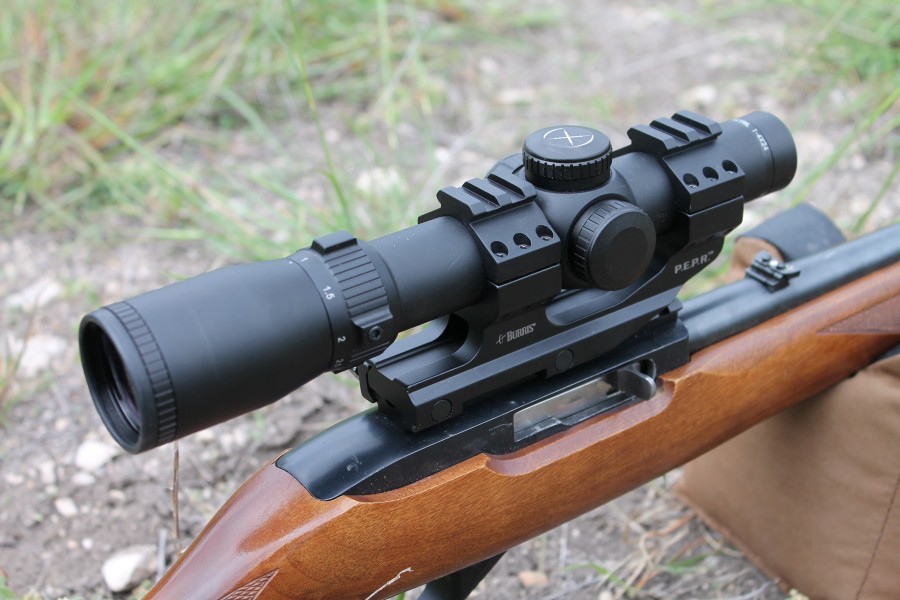
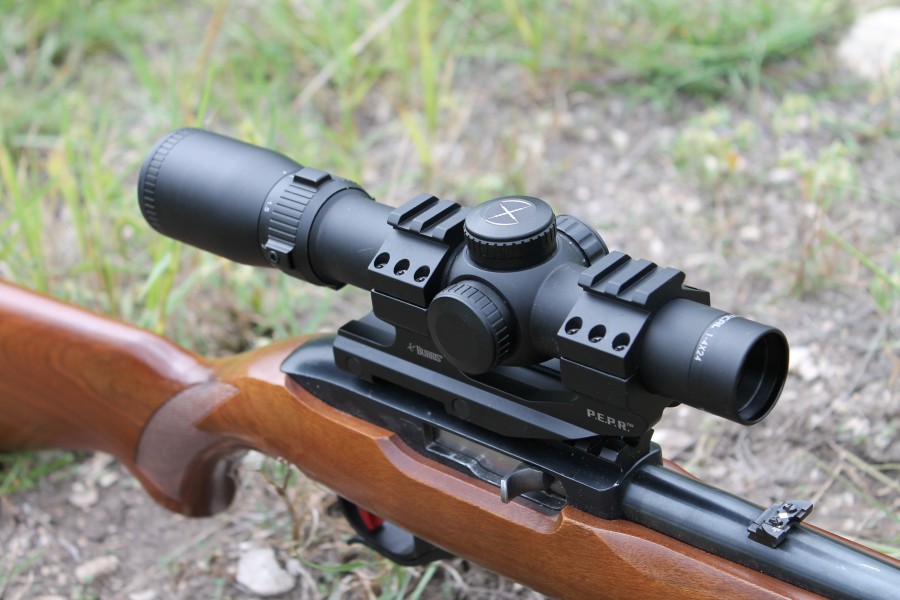

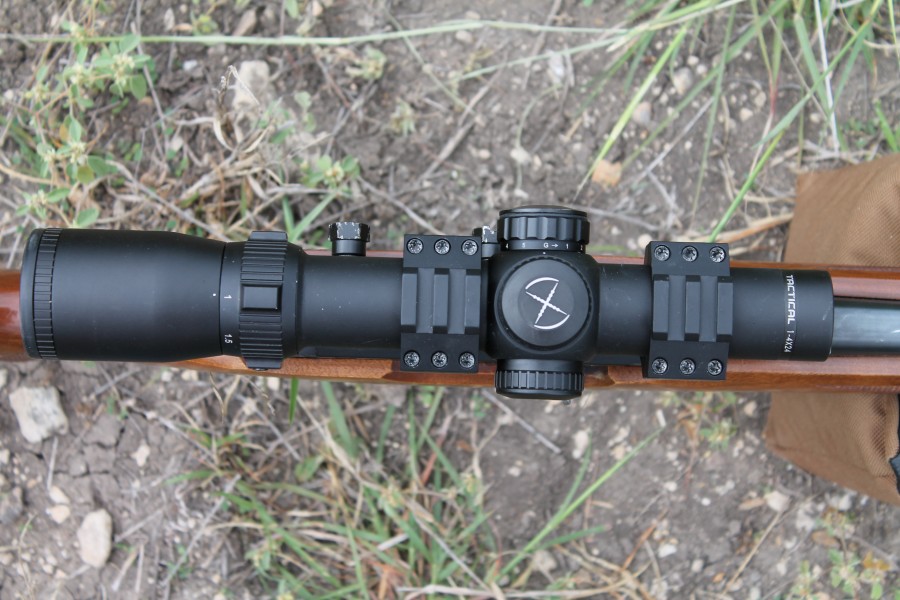



What is that thing sitting atop the scope in picture #5 (counting down from the top)?
that’s a Streamlight TLR-1 HP flashlight
Review to come soon on that Streamlight
I’ve used the low-powered Leupold variables on my ARs and .22 semi-auto carbines for decades, with excellent results. Check out the Leupold VX-1 shotgun/muzzleloader scope (in the same price range as the reviews scope); it can be a great addition to any general-purpose rifle/carbine.
I would love to see a stackup of some of the popular 1-4, 1-6 scopes here on TTAG. I used to not “get” what these were all about, but now after reading several reviews, I seriously want several for my .223 AKs.
The only problem so far has been that most of the good units are north of $500. I’ve never spent more than $150 on a scope so that’s rather steep to me.
I was just reading reviews on the SWFA 1-6 HD the other day and was ready to hit the BUY NOW button until I saw the price tag of A GRAND… Holy shit.
The only thing I find missing from the review here is a peek at the illumination. What’s the illuminated reticle look like?
I have been fiending for 1-4 and 1-6 scopes for a few weeks now. 1-6 scopes seem to be around the $1000 mark so I have ruled them out. I was also looking at the Vortex Viper 1-4 for my AR. It is right at $500 bucks and I have also seen good reviews on it. I have a converted Saiga in .308 I wanted to put a low power scope on to give me a little bit of magnification. I found the Leatherwood CMR a few months ago for $300 which seemed to have good reviews. It even looks like it belongs on an AK. The other good thing is it has markings for .223 and .308 so if I want to swap it to one of my ARs, I can easily do that. I haven’t pulled the trigger yet because I have a few other things to buy before I add glass to my Saiga.
Pretty happy so far with my Burris TAC30. Got it and the QD P.E.P.R. mount for $310.16 shipped thanks to a sale price + coupon code at OpticsPlanet. MSRP would have you at $100 higher, though. I’d love to compare it directly against this Traditions piece plus a Leupold and Vortex, etc. Kee and Foghorn, next time you guys are getting together let me know and I’ll mail you my Burris to borrow if you don’t already have one handy.
The TAC30 and newer MTAC30 have a great lighted reticle and a true 1x (as far as I can tell), which works just as well for me as a red dot as a real red dot does. Being able to zoom to 4x is great and the reticle does offer aiming points for long range shooting.
My only complaint is that I wish these scopes could be 1/3 the size and weight. The scope + mount adds a lot of size/weight to the top of my Tavor. The tiny little Bushnell TRS-25 red dot barely existed in comparison. Big fan of that optic also, but no zoom for longer work. That said, the 3 MOA dot is small and crisp enough that I could reliably hit a 6″ plate from 100 yards offhand. Much beyond that and I start to feel like the dot is large enough that it covers up too much of the target to be precise.
What a super generous offer! Thank you!
I sure like that Ruger. I did similar for my Ruger .44 Mag Carbine. Mounted a Nikon Dangerous Game scope. 1-4x, 30mm tube, and the German #4 reticle. Wanted an illuminated dot, but couple go a couple hundred more two years ago… The Traditions scope has me very interested. I’m completely sold on a 1-4x platform.
Have my Ruger sighted in at 100 yards and get 2-3″ five shot groups. Won’t use it for true dangerous game, but set the rifle up as a hog gun. Have the iron sights locked in at 50 yards and used quick detachable scope rings so I could move the irons as needed. Haven’t used it for hogs yet as my hapless brother gave up his deer lease in TX, but someday I’ll get out with it. Or use it to noisily restore order to my neighborhood if ever the need arises. Damn but I love that carbine.
I hate the name of that Nikon though and I used a black Sharpie to color out the gold buffalo head on the scope. Sort of pretentious I thought.
Nice review, Mr. Kee.
I am confused. With only 1-4x magnification, why a variable power scope instead of a single power 4x? I have a 4x on my .22 rifle that I use to shoot dime size targets at 25 yards and cans etc. at 100. why would anyone want less power at these ranges?
I don’t see a lot of fixed 4X scopes (which I’d love). The only one I found rated for centerfire was a Weaver branded one.
Leupold makes a full range of fixed power scopes, including a 4x, in the VX II line, available many places including optics planet.
Mufti Range Rifle Competition (2/3 Gun) for one.
For me, the 1 or 2 power in my 1-4x scope is really handy shooting from 0 to 50 yards, particularly on moving targets. Has a huge field of view over a fixed 4x scope. I do own and use 4x scopes on several rimfires because, like you, that is sufficient for shooting at even small, non-moving targets up to 100 yards or so. But I set up my Ruger carbine more as a hunting rifle.
Anticipating a lot of hunting in scrub and brush in TX, I wanted max field of view at closer range. Of course I could just go with iron sights, but I’ve got older eyes and the crosshairs even at 1x are much better for me than basic iron sights (that would be different for aperture sights).
On a .22LR? I have no idea. On a defensive or hunting rifle, the low power (1 or 1.5) opens up the field of view and also makes it easy to shoot with two eyes open, which is something you’ll do if the hog is 9 feet away from you and closing. Tactical competitions throw in a mix of long range and very short range targets to make you buy fancier scopes. Just my opinion. Tactically a red do or HWS is fine under 200 meters, no?
For hunting the short variables, 1.5-5x or 1-6x (or 1.1-10x for the highest-end scopes) make much more sense to me, because longer shots on small targets really do happen in the same two minutes as a close-in boar and you have the time, often, to turn up the power for the 200 yard target. In tactical encounters I believe that time to turn up (or down) the power is unlikely to exist, though I only used metal sights tactically, so who knows? That is the reason that tactical military scopes are so often fixed 4x with a supplemental red dot, perhaps.
In all, though, I think the the 1 to 6 is a great class of scope.
Mark, even 3-4x can be too much magnification if the targets are close and/or moving, and 1-2x isn’t enough for longer distance, smaller, or partially hidden targets. I don’t use my 1-4x variable scope very much except on the highest and lowest powers, although 3x gets used occasionally to compare it to other 3x optics.
Because if the scope does “true 1x” (or something reasonably close to it), then it can work almost as well as a red dot for quick shots, because your eyes don’t need to readjust for a different picture when the scope is up, and because you can use it with both eyes open. It also means that you can aim the weapon while moving without losing track of what’s in the scope.
2-7X32mm
Just sayin’!
Just bought a leupold 2-7 myself. Can’t wait to put it through its paces.
I used something similar on my .375 H&H for game in Africa. I love it. And it takes a pounding.
Good review. It would have been a bit better in my opinion if you had removed the caps on the turrets so we could have a look.
Does the turrets have an audible click? Is there good tactile feedback? Does it sound/feel like metal on metal or are they soft and mushy?
Made in China?
I will never buy from Cheaper than Dirt again. I’d rather pay double than to give another cent.
MY question, is THIS: WILL this scope perform the way it did in your test, when mounted on something “stouter” than a .22 LR? It’s one thing, to have a scope “perform like a champ” on my 10/22, and quite something ELSE, to have it do the same on a full-power AR, AK, or FAL platform.
Comments are closed.